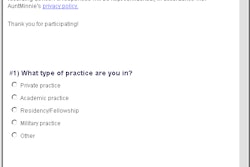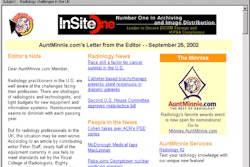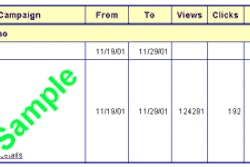NEW ORLEANS - Look inside an imaging facility and you're bound to see employees at both ends of the spectrum. At one end are the ambitious go-getters who are up for any challenge. These employees are self-motivated, willing to go the extra mile, and let’s face it, the ones most likely to bolt the minute a better job offer comes along.
Then there are the more blasé workers, for whom employment is merely a way to pay the bills. Their contribution to a facility’s growth may be rote and adequate, but the employer is pretty much guaranteed that they're in it for the long haul.
How can a radiology administrator keep both kinds of workers -- and everyone in between -- on-board and happy? A career-advancement program is one option, according to Shirley Pinette, manager of breast imaging and outpatient radiology at the Yale-New Haven Hospital in New Haven, CT.
The key to designing an effective employee-retention program is to differentiate between a job and a career, Pinette said on Sunday in a presentation at the 2002 American Healthcare Radiology Administrators meeting.
"A job is an activity performed in exchange for payment," Pinette said, paraphrasing Webster’s Dictionary. "Basically, you get paid to do a job. A career, on the other hand, is a course of continued progress, or a profession for which one undergoes special training, which is undertaken as a permanent calling."
In an order to encourage employees at her institution to work on their careers rather than just their jobs, the Career Advancement Program (CAP) was drawn up. The program is still a work in progress, Pinette said, but she hopes to implement it by 2003 in her 300-person department, which contends with the staffing issues that plague radiology in general.
"At this time, we are experiencing increased workloads in the radiology department, major staffing shortages, and low job satisfaction. Many institutions are offering big incentives, trying to steal our staff away," she said.
The overall goal of CAP is to reward professional excellence, enhance motivation, and improve staff retention. Some of the program’s benefits are the empowerment of employees through a system of equitable rewards; improvement in the quality of patient care; and cross-training and competency in multiple areas.
Employees are given the opportunity to excel in three areas under the model Pinette discussed: Professional practice means becoming involved in day-to-day operations, whether by joining a hospital committee or developing a new imaging protocol. Points can be earned in professional development by presenting in-service lectures or authoring an article.
Finally, personal development marks are gained through continuing education above job requirements or attending a lecture and sharing this new knowledge with the department.
CAP also focuses on three career tracks: imager (radiologic technologists), business services (receptionists, schedulers) and transporters (patient transport). Pinette emphasized that career-advancement programs must include all department personnel.
"These are the people that, I’d say, 99% of the time, are the first people to see our patients," she explained. "They are the people that we really like to have a positive attitude. Everybody knows that if a patient comes to the reception desk, and the receptionist pays absolutely no mind to them, by the time the technologist gets to that patient, you already have an angry patient."
Regardless of the track, the employees must meet one of three career levels, with Level I as the most basic in which staff is proficient in all routine tasks. In Level II, they must also work beyond their current job description. Level III is reserved for employees who demonstrate excellence and are hailed as role models.
Progress up the career ladder is charted through an annual portfolio maintained by the employee. Before their review date with management, the employee must submit a personal resumé, a list of references, and documents that Pinette called exemplars.
"Exemplars are written examples of an instance where the person has gone above and beyond the call of duty," Pinette said. "Another (type of) exemplar would be a situation where the person has faced a challenge at work and went about resolving it."
The portfolio is then reviewed within 30 days by management, which determine if an employee has reached one of the three levels.
Pinette’s group is still hashing out other aspects of CAP, including the most effective way to offer monetary rewards to an outstanding employee, either with a lump sum or with a percentage of their current salary. They are also ironing out some of the wrinkles that they have run into while creating CAP, such as where to place senior employees and experienced new employees in the three levels.
"Progress is not an employee’s given right," she said. "It is earned. This is something that they have to earn through individual motivation, commitment, and perseverance on the job."
Pinette summarized the benefits of programs like CAP: For employees, they include increased productivity, increased staff motivation, and an investment in departmental quality. For management, such programs can help retain current employees, attract well-qualified new ones, and enable a facility to provide quality services.
By Shalmali Pal
AuntMinnie.com staff writer
July 29, 2002
Copyright © 2002 AuntMinnie.com



















